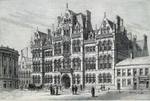University College Birmingham

University College Birmingham is a university in Birmingham, England. It was awarded full university status in 2012 along with Newman University. It is not a member of Universities UK. The university was awarded 'University of the Year' in the 2022 WhatUni Student Choice Awards, as well as coming first in the 'Student Support' category.The university is located in central Birmingham and offers both vocational and academic education at both undergraduate and postgraduate level. The university specialises in the areas of hospitality and the culinary arts, hairdressing and beauty, tourism, business enterprise, marketing, business management, accounting, finance, events management, sports management, sports medicine, sports therapy and Early Years education.
Excerpt from the Wikipedia article University College Birmingham (License: CC BY-SA 3.0, Authors, Images).University College Birmingham
Summer Row, Birmingham Ladywood
Geographical coordinates (GPS) Address Nearby Places Show on map
Geographical coordinates (GPS)
| Latitude | Longitude |
|---|---|
| N 52.4817 ° | E -1.9062 ° |
Address
University College Birmingham
Summer Row
B3 1JB Birmingham, Ladywood
England, United Kingdom
Open on Google Maps










